All Exams >
EmSAT Achieve >
Physics for EmSAT Achieve >
All Questions
All questions of Mechanisms of Heat Transfer for EmSAT Achieve Exam
The temperature range upto which Newton’s law of cooling holds good- a)30-35°C
- b)25-30°C
- c)30-40°C
- d)20-25°C
Correct answer is option 'D'. Can you explain this answer?
The temperature range upto which Newton’s law of cooling holds good
a)
30-35°C
b)
25-30°C
c)
30-40°C
d)
20-25°C
|
|
Hansa Sharma answered |
Newton’s law of cooling is to be used at temperatures around room temperature.
The heat of sun comes to us through:- a)convection
- b)conduction
- c)Sublimation
- d)Radiation
Correct answer is option 'D'. Can you explain this answer?
The heat of sun comes to us through:
a)
convection
b)
conduction
c)
Sublimation
d)
Radiation
|
|
Om Desai answered |
The sun heats the earth through radiation. Since there is no medium (like the gas in our atmosphere) in space, radiation is the primary way that heat travels in space. When the heat reaches the earth it warms the molecules of the atmosphere, and they warm other molecules and so on.
The process by which heat is transferred from one place to another without heating the intervening medium is known as- a)convection
- b)radiation
- c)sublimation
- d)fusion
Correct answer is option 'B'. Can you explain this answer?
The process by which heat is transferred from one place to another without heating the intervening medium is known as
a)
convection
b)
radiation
c)
sublimation
d)
fusion

|
Pioneer Academy answered |
Radiation alludes to the mechanism in which heat is transmitted without any physical contact between objects. It uses electromagnetic waves for transfer of heat.
What is the expression for temperature gradient?- a)

- b)

- c)

- d)

Correct answer is option 'C'. Can you explain this answer?
What is the expression for temperature gradient?
a)
b)
c)
d)
|
|
Krishna Iyer answered |
A temperature gradient is a physical quantity that describes in which direction and at what rate the temperature changes the most rapidly around a particular location.
The temperature gradient is a dimensional quantity expressed in units of degrees per unit length.
The SI unit is kelvin per meter.
Expression: ∆T/∆x, where ∆T = change in temperature and ∆x = change in distance
The temperature gradient is a dimensional quantity expressed in units of degrees per unit length.
The SI unit is kelvin per meter.
Expression: ∆T/∆x, where ∆T = change in temperature and ∆x = change in distance
Newton’s law of cooling states that the rate of cooling of a body is proportional to the _____________________.- a)temperature of the surroundings
- b)excess temperature of the body over the surroundings
- c)temperature of the body
- d)temperature of the body + temperature of the surroundings
Correct answer is option 'B'. Can you explain this answer?
Newton’s law of cooling states that the rate of cooling of a body is proportional to the _____________________.
a)
temperature of the surroundings
b)
excess temperature of the body over the surroundings
c)
temperature of the body
d)
temperature of the body + temperature of the surroundings
|
|
Geetika Shah answered |
Newton's law of cooling states that the heat released by a body with respect to time (or) the rate of heat released is directly proportional to the difference between the body's temperature and the surrounding temperature.
dH/dt = k(T – Ts) where t = surrounding's temperature and T = temperature of the body
Consider two bodies A and B, of equal surface areas, such that A's temperature is more that B's temperature and the surrounding temperature is less than both A and B. Then according to Newton's law of cooling A loses more heat to the surroundings when compared B during the same time interval. So, A will cool faster than B.
dH/dt = k(T – Ts) where t = surrounding's temperature and T = temperature of the body
Consider two bodies A and B, of equal surface areas, such that A's temperature is more that B's temperature and the surrounding temperature is less than both A and B. Then according to Newton's law of cooling A loses more heat to the surroundings when compared B during the same time interval. So, A will cool faster than B.
What should be the temperature of black body to emit radiant energy which is independent of the conditions in the surroundings?- a)temperature of black body should be less than zero
- b)temperature of black body should be more than zero
- c)temperature of black body should be equal to zero
- d)all of the above
Correct answer is option 'B'. Can you explain this answer?
What should be the temperature of black body to emit radiant energy which is independent of the conditions in the surroundings?
a)
temperature of black body should be less than zero
b)
temperature of black body should be more than zero
c)
temperature of black body should be equal to zero
d)
all of the above
|
|
Suresh Reddy answered |
Temperature of black body should be more than zero. Obvious answer. If the temperature is not greater than 0 then there will be no radiation.
What is the coefficient of thermal conductivity K?- a)ΔQt
- b)

- c)

- d)

Correct answer is option 'C'. Can you explain this answer?
What is the coefficient of thermal conductivity K?
a)
ΔQt
b)
c)
d)

|
Ciel Knowledge answered |
K is rate of change of charge.
Mercury is a liquid which is heated by:- a)Convection
- b)Radiation
- c)Conduction
- d)transfusion
Correct answer is option 'C'. Can you explain this answer?
Mercury is a liquid which is heated by:
a)
Convection
b)
Radiation
c)
Conduction
d)
transfusion
|
|
Geetika Shah answered |
Hg expands on heat (thermometers) it acts as a good conducting metal.
Value of coefficient of thermal coefficient is:- a)same incase of conductors and insulators
- b)Good incase of conductors and small incase of insulators
- c)Does not depend on insulators and conductors
- d)Small incase of insulators and good incase of insulators
Correct answer is option 'B'. Can you explain this answer?
Value of coefficient of thermal coefficient is:
a)
same incase of conductors and insulators
b)
Good incase of conductors and small incase of insulators
c)
Does not depend on insulators and conductors
d)
Small incase of insulators and good incase of insulators
|
|
Raghav Bansal answered |
Conductors have free electrons in them whereas insulators don’t have any. Therefore, conductors conduct heat and electricity better than insulators. Therefore the value of thermal coefficient is good in case of conductors and less in case in insulators.
Which of the given phenomenon is not related to convection?- a)In winter metallic handles appear colder than wooden door
- b)Maintaining comfortable room temperature in cold countries
- c)Formation of trade winds
- d)Formation of land and sea breezes
Correct answer is option 'A'. Can you explain this answer?
Which of the given phenomenon is not related to convection?
a)
In winter metallic handles appear colder than wooden door
b)
Maintaining comfortable room temperature in cold countries
c)
Formation of trade winds
d)
Formation of land and sea breezes
|
|
Stuti Joshi answered |
Introduction:
Convection is a mode of heat transfer that occurs due to the movement of a fluid. It involves the transfer of heat energy through the bulk movement of molecules within a fluid such as air or water. Convection can occur in various scenarios, but not all phenomena are related to convection.
Explanation:
Let's analyze each option to determine which one is not related to convection:
a) In winter metallic handles appear colder than wooden door:
This phenomenon is not related to convection. It is actually related to the thermal conductivity of different materials. Metals, such as metallic handles, have higher thermal conductivity compared to wood. Therefore, when touched, metallic handles conduct heat away from our hands more rapidly than wooden doors, making them feel colder.
b) Maintaining comfortable room temperature in cold countries:
This phenomenon is related to convection. In cold countries, the temperature inside a room can be maintained at a comfortable level by using heating systems such as radiators or heaters. These devices heat the air in the room, causing it to expand and rise. As the warm air rises, it creates a convection current, distributing the heat throughout the room.
c) Formation of trade winds:
This phenomenon is related to convection. Trade winds are a pattern of prevailing winds that blow from east to west in the equatorial region. They are formed due to the convectional heating of air near the equator. The intense solar radiation at the equator heats the air, causing it to expand and rise. As the air rises, it creates a low-pressure zone, and the cooler air from higher latitudes flows in to replace it, resulting in the formation of trade winds.
d) Formation of land and sea breezes:
This phenomenon is related to convection. Land and sea breezes are local winds that occur near coastal areas. During the day, the land heats up more quickly than the sea. The warm air over the land rises, creating a low-pressure zone, and the cooler air from the sea flows in to replace it, resulting in the formation of a sea breeze. At night, the land cools down more rapidly than the sea, causing the warm air to rise over the sea and the cooler air from the land to flow in, resulting in the formation of a land breeze.
Conclusion:
Out of the given options, the phenomenon of metallic handles appearing colder than wooden doors in winter is not related to convection. It is primarily influenced by the thermal conductivity of different materials. Convection, on the other hand, is involved in maintaining room temperature, formation of trade winds, and land and sea breezes.
Convection is a mode of heat transfer that occurs due to the movement of a fluid. It involves the transfer of heat energy through the bulk movement of molecules within a fluid such as air or water. Convection can occur in various scenarios, but not all phenomena are related to convection.
Explanation:
Let's analyze each option to determine which one is not related to convection:
a) In winter metallic handles appear colder than wooden door:
This phenomenon is not related to convection. It is actually related to the thermal conductivity of different materials. Metals, such as metallic handles, have higher thermal conductivity compared to wood. Therefore, when touched, metallic handles conduct heat away from our hands more rapidly than wooden doors, making them feel colder.
b) Maintaining comfortable room temperature in cold countries:
This phenomenon is related to convection. In cold countries, the temperature inside a room can be maintained at a comfortable level by using heating systems such as radiators or heaters. These devices heat the air in the room, causing it to expand and rise. As the warm air rises, it creates a convection current, distributing the heat throughout the room.
c) Formation of trade winds:
This phenomenon is related to convection. Trade winds are a pattern of prevailing winds that blow from east to west in the equatorial region. They are formed due to the convectional heating of air near the equator. The intense solar radiation at the equator heats the air, causing it to expand and rise. As the air rises, it creates a low-pressure zone, and the cooler air from higher latitudes flows in to replace it, resulting in the formation of trade winds.
d) Formation of land and sea breezes:
This phenomenon is related to convection. Land and sea breezes are local winds that occur near coastal areas. During the day, the land heats up more quickly than the sea. The warm air over the land rises, creating a low-pressure zone, and the cooler air from the sea flows in to replace it, resulting in the formation of a sea breeze. At night, the land cools down more rapidly than the sea, causing the warm air to rise over the sea and the cooler air from the land to flow in, resulting in the formation of a land breeze.
Conclusion:
Out of the given options, the phenomenon of metallic handles appearing colder than wooden doors in winter is not related to convection. It is primarily influenced by the thermal conductivity of different materials. Convection, on the other hand, is involved in maintaining room temperature, formation of trade winds, and land and sea breezes.
The mechanism of transfer of heat between two adjacent parts of a body because of their temperature difference is known as- a)conduction
- b)convection
- c)Sublimation
- d)Fusion
Correct answer is option 'A'. Can you explain this answer?
The mechanism of transfer of heat between two adjacent parts of a body because of their temperature difference is known as
a)
conduction
b)
convection
c)
Sublimation
d)
Fusion
|
|
Geetika Shah answered |
The mechanism of transfer of heat between two adjacent parts of a body because of their temperature difference is known as conduction. This is the definition of conduction.
The process by which heat flows from the region of higher temperature to the region of lower temperature by actual movement of material particles is called- a)Sublimation
- b)radiaton
- c)Conduction
- d)Convection
Correct answer is option 'D'. Can you explain this answer?
The process by which heat flows from the region of higher temperature to the region of lower temperature by actual movement of material particles is called
a)
Sublimation
b)
radiaton
c)
Conduction
d)
Convection
|
|
Rajat Patel answered |
In this process, heat is transferred in the liquid and gases from a region of higher temperature to a region of lower temperature. Convection heat transfer occurs partly due to the actual movement of molecules or due to the mass transfer.
SI unit of thermal conductivity is- a)Js K
- b)Js-1 K
- c)Js K-1
- d)Jm-1s-1 K-1
Correct answer is option 'D'. Can you explain this answer?
SI unit of thermal conductivity is
a)
Js K
b)
Js-1 K
c)
Js K-1
d)
Jm-1s-1 K-1
|
|
Pooja Shah answered |
K = power × thickness (m) ÷ area × ∆T
K = (J s-1) (m) ÷ (m2) (K)
K = J m-1 s-1 k-1
K = (J s-1) (m) ÷ (m2) (K)
K = J m-1 s-1 k-1
If the temperature difference between the body and surrounding is small, then the rate of loss of heat is directly proportional to- a)Temperature of two bodies
- b)Nature of two bodies
- c)Pressure difference of the body
- d)Size of the two bodies
Correct answer is option 'A'. Can you explain this answer?
If the temperature difference between the body and surrounding is small, then the rate of loss of heat is directly proportional to
a)
Temperature of two bodies
b)
Nature of two bodies
c)
Pressure difference of the body
d)
Size of the two bodies
|
|
Hansa Sharma answered |
The rate of loss of heat by a body is directly proportional to its excess temperature over that of the surroundings provided that this excess is small.
Among the following methods of heat transfer, gravity does not play any part in- a)Convection
- b)Radiation and conduction
- c)radiation
- d)convection and conduction
Correct answer is option 'B'. Can you explain this answer?
Among the following methods of heat transfer, gravity does not play any part in
a)
Convection
b)
Radiation and conduction
c)
radiation
d)
convection and conduction
|
|
Rajat Patel answered |
Gravity does not play any part in radiation and conduction because in both these processes heat is transferred without any motion of the medium particles.
Assertion :The equivalent thermal conductivity of two plates of same thickness in contact is less than the smaller value of thermal conductivity
Reason: For two plates of equal thickness in contact the equivalent thermal conductivity is given by:
1/K=1/K1+1/K2
- a)Assertion is correct but Reason is incorrect
- b)Both Assertion and Reason are correct but Reason is not the correct explanation for Assertion
- c)Both Assertion and Reason are correct and Reason is the correct explanation for Assertion
- d)Both Assertion and Reason are incorrect
Correct answer is option 'C'. Can you explain this answer?
Assertion :The equivalent thermal conductivity of two plates of same thickness in contact is less than the smaller value of thermal conductivity
Reason: For two plates of equal thickness in contact the equivalent thermal conductivity is given by:
1/K=1/K1+1/K2
1/K=1/K1+1/K2
a)
Assertion is correct but Reason is incorrect
b)
Both Assertion and Reason are correct but Reason is not the correct explanation for Assertion
c)
Both Assertion and Reason are correct and Reason is the correct explanation for Assertion
d)
Both Assertion and Reason are incorrect

|
Stepway Academy answered |
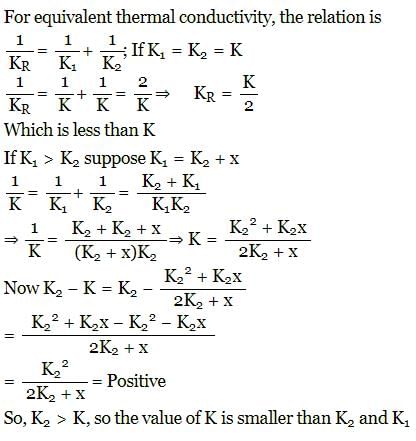
Attempt All sub parts from each question.Railway track expansion joint: Expansion and contraction of steel and concrete structure due to seasonal heating and cooling is a common problem found in civil engineering. To combat this problem, engineers put expansion joints to absorb these changes. This problem is compounded on railway tracks. This could lead to rail buckling, known in the industry as “sun kink”, as shown below, and cause the derailment of train. When exposed to temperature variations, the rail tends to vary its length. If this tendency is freely allowed, for a temperature
This problem is compounded on railway tracks. This could lead to rail buckling, known in the industry as “sun kink”, as shown below, and cause the derailment of train. When exposed to temperature variations, the rail tends to vary its length. If this tendency is freely allowed, for a temperature variance Δt, the rail length L will vary by ΔL. This length variance can be computed as:ΔL = αLΔtwhere α = expansion coefficient of steel= 11.5 x 10–6 °C.The coefficient of thermal expansion is defined as the fractional increase in length per unit rise in temperature. Traditional railway tracks are of standard lengths. When the tracks are laid, the lengths are joined end to end using “fishplates”—short lengths of steel plate overlapping the joint, and bolted to the ends of the rails. At each joint there must be a short gap (≈ 1/8") between the rail ends, to allow for longitudinal thermal expansion of the rails on hot days.Q. Which of the following statement is true?
variance Δt, the rail length L will vary by ΔL. This length variance can be computed as:ΔL = αLΔtwhere α = expansion coefficient of steel= 11.5 x 10–6 °C.The coefficient of thermal expansion is defined as the fractional increase in length per unit rise in temperature. Traditional railway tracks are of standard lengths. When the tracks are laid, the lengths are joined end to end using “fishplates”—short lengths of steel plate overlapping the joint, and bolted to the ends of the rails. At each joint there must be a short gap (≈ 1/8") between the rail ends, to allow for longitudinal thermal expansion of the rails on hot days.Q. Which of the following statement is true?- a)Expansion joint maintain 1/8” gap whatever be the temperature change
- b)Expansion joint increases when temperature decreases and decreases when temperature increases.
- c)Expansion joint decreases when temperature decreases and increases when temperature increases.
- d)Expansion joints expands with the rise of temperature
Correct answer is option 'B'. Can you explain this answer?
Attempt All sub parts from each question.
Railway track expansion joint: Expansion and contraction of steel and concrete structure due to seasonal heating and cooling is a common problem found in civil engineering. To combat this problem, engineers put expansion joints to absorb these changes.

This problem is compounded on railway tracks. This could lead to rail buckling, known in the industry as “sun kink”, as shown below, and cause the derailment of train. When exposed to temperature variations, the rail tends to vary its length. If this tendency is freely allowed, for a temperature

variance Δt, the rail length L will vary by ΔL. This length variance can be computed as:
ΔL = αLΔt
where α = expansion coefficient of steel
= 11.5 x 10–6 °C.
The coefficient of thermal expansion is defined as the fractional increase in length per unit rise in temperature. Traditional railway tracks are of standard lengths. When the tracks are laid, the lengths are joined end to end using “fishplates”—short lengths of steel plate overlapping the joint, and bolted to the ends of the rails. At each joint there must be a short gap (≈ 1/8") between the rail ends, to allow for longitudinal thermal expansion of the rails on hot days.
Q. Which of the following statement is true?
a)
Expansion joint maintain 1/8” gap whatever be the temperature change
b)
Expansion joint increases when temperature decreases and decreases when temperature increases.
c)
Expansion joint decreases when temperature decreases and increases when temperature increases.
d)
Expansion joints expands with the rise of temperature
|
|
Gaurav Kumar answered |
Normally 1/8’ gap is left when two railway track ends are joined with fishplate. When temperature rises, the rail tracks expand and this gap accommodates the expansion of the steel track. So, the gap contracts. When temperature decreases, the rail tracks contract and this gap increases.
Read the assertion and reason carefully to mark the correct option out of the options given below:Assertion : If the temperature of a star is doubled then the rate of loss of heat from it becomes 16 times.Reason : Specific heat varies with temperature.- a)If both assertion and reason are true and the reason is the correct explanation of the assertion.
- b)If both assertion and reason are true but reason is not the correct explanation of the assertion.
- c)If assertion is true but reason is false.
- d)If the assertion and reason both are false.
Correct answer is option 'B'. Can you explain this answer?
Read the assertion and reason carefully to mark the correct option out of the options given below:
Assertion : If the temperature of a star is doubled then the rate of loss of heat from it becomes 16 times.
Reason : Specific heat varies with temperature.
a)
If both assertion and reason are true and the reason is the correct explanation of the assertion.
b)
If both assertion and reason are true but reason is not the correct explanation of the assertion.
c)
If assertion is true but reason is false.
d)
If the assertion and reason both are false.
|
|
Jyoti Dey answered |
Assertion : If the temperature of a star is doubled then the rate of loss of heat from it becomes 16 times.
Reason : Specific heat varies with temperature.
The correct answer is option B. Both the assertion and reason are true, but the reason is not the correct explanation of the assertion.
Explanation:
Assertion: If the temperature of a star is doubled, then the rate of loss of heat from it becomes 16 times.
Reason: Specific heat varies with temperature.
Explanation:
The rate of heat loss from a star is determined by various factors, including the temperature and the specific heat capacity of the material of the star. However, the specific heat capacity alone does not determine the rate of heat loss.
Specific heat capacity is the amount of heat required to raise the temperature of a unit mass of a substance by a certain amount. It is a property of the material and is typically measured in units of J/(kg·K).
When the temperature of a star is doubled, the rate of heat loss from the star does not necessarily become 16 times. The rate of heat loss depends on various factors such as the surface area, emissivity, and temperature difference between the star and its surroundings.
The specific heat capacity of a substance only affects the amount of heat required to raise its temperature, but it does not directly determine the rate at which heat is lost. Therefore, the reason given in the assertion is not the correct explanation for the relationship between the temperature of a star and its rate of heat loss.
Hence, the correct answer is option B. Both the assertion and reason are true, but the reason is not the correct explanation of the assertion.
Reason : Specific heat varies with temperature.
The correct answer is option B. Both the assertion and reason are true, but the reason is not the correct explanation of the assertion.
Explanation:
Assertion: If the temperature of a star is doubled, then the rate of loss of heat from it becomes 16 times.
Reason: Specific heat varies with temperature.
Explanation:
The rate of heat loss from a star is determined by various factors, including the temperature and the specific heat capacity of the material of the star. However, the specific heat capacity alone does not determine the rate of heat loss.
Specific heat capacity is the amount of heat required to raise the temperature of a unit mass of a substance by a certain amount. It is a property of the material and is typically measured in units of J/(kg·K).
When the temperature of a star is doubled, the rate of heat loss from the star does not necessarily become 16 times. The rate of heat loss depends on various factors such as the surface area, emissivity, and temperature difference between the star and its surroundings.
The specific heat capacity of a substance only affects the amount of heat required to raise its temperature, but it does not directly determine the rate at which heat is lost. Therefore, the reason given in the assertion is not the correct explanation for the relationship between the temperature of a star and its rate of heat loss.
Hence, the correct answer is option B. Both the assertion and reason are true, but the reason is not the correct explanation of the assertion.
Which is the fastest mode of heat transfer?- a)convection
- b)conduction
- c)Transition
- d)Radiation
Correct answer is option 'D'. Can you explain this answer?
Which is the fastest mode of heat transfer?
a)
convection
b)
conduction
c)
Transition
d)
Radiation
|
|
Arun Khanna answered |
Answer: Radiation is the fastest mode of transfer of heat, because radiation travels at the speed of light, which is very quick. The slowest mode of transfer of heat is conduction because it takes place from particle to particle.
What are units of K?- a)Wm-2K-1
- b)WmK
- c)Wm-1K-1
- d)Wm-1K-2
Correct answer is option 'C'. Can you explain this answer?
What are units of K?
a)
Wm-2K-1
b)
WmK
c)
Wm-1K-1
d)
Wm-1K-2
|
|
Arun Khanna answered |
So for a first order reaction, so for first order, a first order reaction rate law is rate is equal to our rate constant k times the concentration of our reactant raised to the first power. Units of rate are molar per second, and the units of concentration are always going to be molar.
Attempt All sub parts from each question.Railway track expansion joint: Expansion and contraction of steel and concrete structure due to seasonal heating and cooling is a common problem found in civil engineering. To combat this problem, engineers put expansion joints to absorb these changes. This problem is compounded on railway tracks. This could lead to rail buckling, known in the industry as “sun kink”, as shown below, and cause the derailment of train. When exposed to temperature variations, the rail tends to vary its length. If this tendency is freely allowed, for a temperature
This problem is compounded on railway tracks. This could lead to rail buckling, known in the industry as “sun kink”, as shown below, and cause the derailment of train. When exposed to temperature variations, the rail tends to vary its length. If this tendency is freely allowed, for a temperature variance Δt, the rail length L will vary by ΔL. This length variance can be computed as:ΔL = αLΔtwhere α = expansion coefficient of steel= 11.5 x 10–6 °C.The coefficient of thermal expansion is defined as the fractional increase in length per unit rise in temperature. Traditional railway tracks are of standard lengths. When the tracks are laid, the lengths are joined end to end using “fishplates”—short lengths of steel plate overlapping the joint, and bolted to the ends of the rails. At each joint there must be a short gap (≈ 1/8") between the rail ends, to allow for longitudinal thermal expansion of the rails on hot days.Q. What is the value of thermal expansion coefficient of steel?
variance Δt, the rail length L will vary by ΔL. This length variance can be computed as:ΔL = αLΔtwhere α = expansion coefficient of steel= 11.5 x 10–6 °C.The coefficient of thermal expansion is defined as the fractional increase in length per unit rise in temperature. Traditional railway tracks are of standard lengths. When the tracks are laid, the lengths are joined end to end using “fishplates”—short lengths of steel plate overlapping the joint, and bolted to the ends of the rails. At each joint there must be a short gap (≈ 1/8") between the rail ends, to allow for longitudinal thermal expansion of the rails on hot days.Q. What is the value of thermal expansion coefficient of steel?- a)1.15 × 10–6 °C.
- b)0.115 × 10–6 °C
- c)11.5 × 10–6 °C.
- d)11.5 × 106 °C
Correct answer is option 'C'. Can you explain this answer?
Attempt All sub parts from each question.
Railway track expansion joint: Expansion and contraction of steel and concrete structure due to seasonal heating and cooling is a common problem found in civil engineering. To combat this problem, engineers put expansion joints to absorb these changes.

This problem is compounded on railway tracks. This could lead to rail buckling, known in the industry as “sun kink”, as shown below, and cause the derailment of train. When exposed to temperature variations, the rail tends to vary its length. If this tendency is freely allowed, for a temperature

variance Δt, the rail length L will vary by ΔL. This length variance can be computed as:
ΔL = αLΔt
where α = expansion coefficient of steel
= 11.5 x 10–6 °C.
The coefficient of thermal expansion is defined as the fractional increase in length per unit rise in temperature. Traditional railway tracks are of standard lengths. When the tracks are laid, the lengths are joined end to end using “fishplates”—short lengths of steel plate overlapping the joint, and bolted to the ends of the rails. At each joint there must be a short gap (≈ 1/8") between the rail ends, to allow for longitudinal thermal expansion of the rails on hot days.
Q. What is the value of thermal expansion coefficient of steel?
a)
1.15 × 10–6 °C.
b)
0.115 × 10–6 °C
c)
11.5 × 10–6 °C.
d)
11.5 × 106 °C
|
|
Suresh Reddy answered |
Expansion coefficient of steel = 11.5 × 10–6 °C.
Attempt All sub parts from each question.Triple Point: The temperature of a substance remains constant during its change of state (phase change). A graph between the temperature T and the Pressure P of the substance is called a phase diagram or P-T diagram. The following figure shows the phase diagram of water and CO2. Such a phase diagram divides the P-T plane into a solid-region, the vapour-region and the liquid-region. The regions are separated by the curves such as sublimation curve (BO), fusion curve (AO) and vaporisation curve (CO). The points on sublimation curve represent states in which solid and vapour phases coexist. The point on the sublimation curve BO represent states in which the solid and vapour phases coexist. Points on the fusion curve AO represent states in which solid and liquid phase coexist. Points on the vaporisation curve CO represent states in which the liquid and vapour phases coexist. The temperature and pressure at which the fusion curve, the vaporisation curve and the sublimation curve meet and all the three phases of a substance coexist is called the triple point of the substance.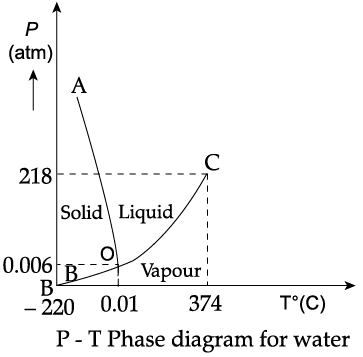
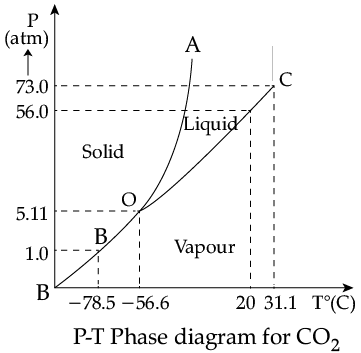 Q. The temperature and pressure at which all the three phases of a substance coexist is called
Q. The temperature and pressure at which all the three phases of a substance coexist is called- a)Boiling point
- b)Freezing point
- c)Triple point
- d)Melting point
Correct answer is option 'C'. Can you explain this answer?
Attempt All sub parts from each question.
Triple Point: The temperature of a substance remains constant during its change of state (phase change). A graph between the temperature T and the Pressure P of the substance is called a phase diagram or P-T diagram. The following figure shows the phase diagram of water and CO2. Such a phase diagram divides the P-T plane into a solid-region, the vapour-region and the liquid-region. The regions are separated by the curves such as sublimation curve (BO), fusion curve (AO) and vaporisation curve (CO). The points on sublimation curve represent states in which solid and vapour phases coexist. The point on the sublimation curve BO represent states in which the solid and vapour phases coexist. Points on the fusion curve AO represent states in which solid and liquid phase coexist. Points on the vaporisation curve CO represent states in which the liquid and vapour phases coexist. The temperature and pressure at which the fusion curve, the vaporisation curve and the sublimation curve meet and all the three phases of a substance coexist is called the triple point of the substance.


Q. The temperature and pressure at which all the three phases of a substance coexist is called
a)
Boiling point
b)
Freezing point
c)
Triple point
d)
Melting point
|
|
Geetika Shah answered |
The temperature and pressure at which the fusion curve, the vaporisation curve and the sublimation curve meet and all the three phases of a substance coexist is called the triple point of the substance.
Attempt All sub parts from each question.Triple Point: The temperature of a substance remains constant during its change of state (phase change). A graph between the temperature T and the Pressure P of the substance is called a phase diagram or P-T diagram. The following figure shows the phase diagram of water and CO2. Such a phase diagram divides the P-T plane into a solid-region, the vapour-region and the liquid-region. The regions are separated by the curves such as sublimation curve (BO), fusion curve (AO) and vaporisation curve (CO). The points on sublimation curve represent states in which solid and vapour phases coexist. The point on the sublimation curve BO represent states in which the solid and vapour phases coexist. Points on the fusion curve AO represent states in which solid and liquid phase coexist. Points on the vaporisation curve CO represent states in which the liquid and vapour phases coexist. The temperature and pressure at which the fusion curve, the vaporisation curve and the sublimation curve meet and all the three phases of a substance coexist is called the triple point of the substance.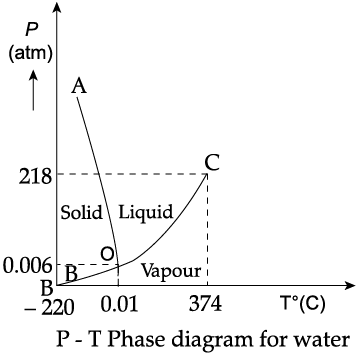
 Q. During phase change of a substance
Q. During phase change of a substance- a)The temperature remains constant
- b)The temperature changes very slowly
- c)The temperature changes very fast
- d)Both temperature and pressure change very slowly
Correct answer is option 'A'. Can you explain this answer?
Attempt All sub parts from each question.
Triple Point: The temperature of a substance remains constant during its change of state (phase change). A graph between the temperature T and the Pressure P of the substance is called a phase diagram or P-T diagram. The following figure shows the phase diagram of water and CO2. Such a phase diagram divides the P-T plane into a solid-region, the vapour-region and the liquid-region. The regions are separated by the curves such as sublimation curve (BO), fusion curve (AO) and vaporisation curve (CO). The points on sublimation curve represent states in which solid and vapour phases coexist. The point on the sublimation curve BO represent states in which the solid and vapour phases coexist. Points on the fusion curve AO represent states in which solid and liquid phase coexist. Points on the vaporisation curve CO represent states in which the liquid and vapour phases coexist. The temperature and pressure at which the fusion curve, the vaporisation curve and the sublimation curve meet and all the three phases of a substance coexist is called the triple point of the substance.


Q. During phase change of a substance
a)
The temperature remains constant
b)
The temperature changes very slowly
c)
The temperature changes very fast
d)
Both temperature and pressure change very slowly
|
|
Preeti Iyer answered |
The temperature of a substance remains constant during its change of state (phase change).
Read the assertion and reason carefully to mark the correct option out of the options given below:Assertion : Woolen clothes keep the body warm in winter.Reason : Air is a bad conductor of heat.- a)If both assertion and reason are true and the reason is the correct explanation of the assertion.
- b)If both assertion and reason are true but reason is not the correct explanation of the assertion.
- c)If assertion is true but reason is false.
- d)If the assertion and reason both are false.
Correct answer is option 'A'. Can you explain this answer?
Read the assertion and reason carefully to mark the correct option out of the options given below:
Assertion : Woolen clothes keep the body warm in winter.
Reason : Air is a bad conductor of heat.
a)
If both assertion and reason are true and the reason is the correct explanation of the assertion.
b)
If both assertion and reason are true but reason is not the correct explanation of the assertion.
c)
If assertion is true but reason is false.
d)
If the assertion and reason both are false.
|
|
Nandini Iyer answered |
Woolen fibres encloses a large amount of air in them. Both wool and air are the bad conductors of heat and the coefficient of thermal conductivity is small. So, they prevent any loss of heat from our body.
Read the assertion and reason carefully to mark the correct option out of the options given below:Assertion : Blue star is at high temperature than red star.Reason : Wein's displacement law states that T∝(1/λm).- a)If both assertion and reason are true and the reason is the correct explanation of the assertion.
- b)If both assertion and reason are true but reason is not the correct explanation of the assertion.
- c)If assertion is true but reason is false.
- d)If the assertion and reason both are false.
Correct answer is option 'A'. Can you explain this answer?
Read the assertion and reason carefully to mark the correct option out of the options given below:
Assertion : Blue star is at high temperature than red star.
Reason : Wein's displacement law states that T∝(1/λm).
a)
If both assertion and reason are true and the reason is the correct explanation of the assertion.
b)
If both assertion and reason are true but reason is not the correct explanation of the assertion.
c)
If assertion is true but reason is false.
d)
If the assertion and reason both are false.
|
|
Nandini Iyer answered |
From Wein's displacement law, temperature (T)∝1/λm (where λm is the maximum wavelength). Thus temperature of a body is inversely proportional to the wavelength. Since blue star has smaller wavelength and red star has maximum wavelength, therefore blue star is at higher temperature then red star.
Read the assertion and reason carefully to mark the correct option out of the options given below:Assertion : A brass tumbler feels much colder than a wooden tray on a chilly day.Reason : The thermal conductivity of brass is less than that of wood.- a)If both assertion and reason are true and the reason is the correct explanation of the assertion.
- b)If both assertion and reason are true but reason is not the correct explanation of the assertion.
- c)If assertion is true but reason is false.
- d)If the assertion and reason both are false.
Correct answer is option 'C'. Can you explain this answer?
Read the assertion and reason carefully to mark the correct option out of the options given below:
Assertion : A brass tumbler feels much colder than a wooden tray on a chilly day.
Reason : The thermal conductivity of brass is less than that of wood.
a)
If both assertion and reason are true and the reason is the correct explanation of the assertion.
b)
If both assertion and reason are true but reason is not the correct explanation of the assertion.
c)
If assertion is true but reason is false.
d)
If the assertion and reason both are false.
|
|
Naina Sharma answered |
The thermal conductivity of brass is high i.e., brass is a good conductor of heat. So, when a brass tumbler is touched, heat quickly flows from human body to tumbler. Consequently, the tumbler appears colder, on the other hand wood is a bad conductor. So, heat does not flow from the human body to the wooden tray in this case. Thus it appears comparatively hotter.
Read the assertion and reason carefully to mark the correct option out of the options given below:Assertion : It is hotter over the top of a fire than at the same distance on the sides.Reason : Air surrounding the fire conducts more heat upwards.- a)If both assertion and reason are true and the reason is the correct explanation of the assertion.
- b)If both assertion and reason are true but reason is not the correct explanation of the assertion.
- c)If assertion is true but reason is false.
- d)If the assertion and reason both are false.
Correct answer is option 'C'. Can you explain this answer?
Read the assertion and reason carefully to mark the correct option out of the options given below:
Assertion : It is hotter over the top of a fire than at the same distance on the sides.
Reason : Air surrounding the fire conducts more heat upwards.
a)
If both assertion and reason are true and the reason is the correct explanation of the assertion.
b)
If both assertion and reason are true but reason is not the correct explanation of the assertion.
c)
If assertion is true but reason is false.
d)
If the assertion and reason both are false.
|
|
Neha Sharma answered |
Heat is carried away from a fire sideways mainly by radiations. Above the fire, heat is carried by both radiation and by convection of air. The latter process carries much more heat.
Read the assertion and reason carefully to mark the correct option out of the options given below:Assertion : Temperatures near the sea coast are moderate.Reason : Water has a high thermal conductivity.- a)If both assertion and reason are true and the reason is the correct explanation of the assertion.
- b)If both assertion and reason are true but reason is not the correct explanation of the assertion.
- c)If assertion is true but reason is false.
- d)If the assertion and reason both are false.
Correct answer is option 'B'. Can you explain this answer?
Read the assertion and reason carefully to mark the correct option out of the options given below:
Assertion : Temperatures near the sea coast are moderate.
Reason : Water has a high thermal conductivity.
a)
If both assertion and reason are true and the reason is the correct explanation of the assertion.
b)
If both assertion and reason are true but reason is not the correct explanation of the assertion.
c)
If assertion is true but reason is false.
d)
If the assertion and reason both are false.
|
|
Suresh Reddy answered |
During the day when water is cooler than the land, the wind blows off the water onto the land (as warm air rises and cooler air fills the place). Also at night, the effect is reversed (since the water is usually warmer than the surrounding air on land). Due to this wind flow the temperature near the sea coast remains moderate.
Read the assertion and reason carefully to mark the correct option out of the options given below:Assertion : A body that is a good radiator is also a good absorber of radiation at a given wavelength.Reason : According to Kirchhoff's law the absorptivity of a body is equal to its emissivity at a given wavelength.- a)If both assertion and reason are true and the reason is the correct explanation of the assertion.
- b)If both assertion and reason are true but reason is not the correct explanation of the assertion.
- c)If assertion is true but reason is false.
- d)If the assertion and reason both are false.
Correct answer is option 'A'. Can you explain this answer?
Read the assertion and reason carefully to mark the correct option out of the options given below:
Assertion : A body that is a good radiator is also a good absorber of radiation at a given wavelength.
Reason : According to Kirchhoff's law the absorptivity of a body is equal to its emissivity at a given wavelength.
a)
If both assertion and reason are true and the reason is the correct explanation of the assertion.
b)
If both assertion and reason are true but reason is not the correct explanation of the assertion.
c)
If assertion is true but reason is false.
d)
If the assertion and reason both are false.
|
|
Suresh Reddy answered |
According to Kirchhoff's law, a = e. or the absorptivity of a body equals its emissivity. A good absorber is a good emitter. As a good absorber is poor reflector, emitting (or radiating) ability of body is oppositely related to its ability to reflect. Therefore good emitter (or radiator) is a poor reflector.
Attempt All sub parts from each question.Railway track expansion joint: Expansion and contraction of steel and concrete structure due to seasonal heating and cooling is a common problem found in civil engineering. To combat this problem, engineers put expansion joints to absorb these changes. This problem is compounded on railway tracks. This could lead to rail buckling, known in the industry as “sun kink”, as shown below, and cause the derailment of train. When exposed to temperature variations, the rail tends to vary its length. If this tendency is freely allowed, for a temperature
This problem is compounded on railway tracks. This could lead to rail buckling, known in the industry as “sun kink”, as shown below, and cause the derailment of train. When exposed to temperature variations, the rail tends to vary its length. If this tendency is freely allowed, for a temperature variance Δt, the rail length L will vary by ΔL. This length variance can be computed as:ΔL = αLΔtwhere α = expansion coefficient of steel= 11.5 x 10–6 °C.The coefficient of thermal expansion is defined as the fractional increase in length per unit rise in temperature. Traditional railway tracks are of standard lengths. When the tracks are laid, the lengths are joined end to end using “fishplates”—short lengths of steel plate overlapping the joint, and bolted to the ends of the rails. At each joint there must be a short gap (≈ 1/8") between the rail ends, to allow for longitudinal thermal expansion of the rails on hot days.Q. At each railway track joint a short gap of ............... (approximately) is left.
variance Δt, the rail length L will vary by ΔL. This length variance can be computed as:ΔL = αLΔtwhere α = expansion coefficient of steel= 11.5 x 10–6 °C.The coefficient of thermal expansion is defined as the fractional increase in length per unit rise in temperature. Traditional railway tracks are of standard lengths. When the tracks are laid, the lengths are joined end to end using “fishplates”—short lengths of steel plate overlapping the joint, and bolted to the ends of the rails. At each joint there must be a short gap (≈ 1/8") between the rail ends, to allow for longitudinal thermal expansion of the rails on hot days.Q. At each railway track joint a short gap of ............... (approximately) is left.- a)1/8 mm
- b)1/8 cm
- c)1/8 m
- d)1/8 inch
Correct answer is option 'D'. Can you explain this answer?
Attempt All sub parts from each question.
Railway track expansion joint: Expansion and contraction of steel and concrete structure due to seasonal heating and cooling is a common problem found in civil engineering. To combat this problem, engineers put expansion joints to absorb these changes.

This problem is compounded on railway tracks. This could lead to rail buckling, known in the industry as “sun kink”, as shown below, and cause the derailment of train. When exposed to temperature variations, the rail tends to vary its length. If this tendency is freely allowed, for a temperature

variance Δt, the rail length L will vary by ΔL. This length variance can be computed as:
ΔL = αLΔt
where α = expansion coefficient of steel
= 11.5 x 10–6 °C.
The coefficient of thermal expansion is defined as the fractional increase in length per unit rise in temperature. Traditional railway tracks are of standard lengths. When the tracks are laid, the lengths are joined end to end using “fishplates”—short lengths of steel plate overlapping the joint, and bolted to the ends of the rails. At each joint there must be a short gap (≈ 1/8") between the rail ends, to allow for longitudinal thermal expansion of the rails on hot days.
Q. At each railway track joint a short gap of ............... (approximately) is left.
a)
1/8 mm
b)
1/8 cm
c)
1/8 m
d)
1/8 inch
|
|
Naina Sharma answered |
At each joint of railway track there must be a short gap (≈ 1/8") between the rail ends, to allow for longitudinal thermal expansion of the rails on hot days.
Attempt All sub parts from each question.Triple Point: The temperature of a substance remains constant during its change of state (phase change). A graph between the temperature T and the Pressure P of the substance is called a phase diagram or P-T diagram. The following figure shows the phase diagram of water and CO2. Such a phase diagram divides the P-T plane into a solid-region, the vapour-region and the liquid-region. The regions are separated by the curves such as sublimation curve (BO), fusion curve (AO) and vaporisation curve (CO). The points on sublimation curve represent states in which solid and vapour phases coexist. The point on the sublimation curve BO represent states in which the solid and vapour phases coexist. Points on the fusion curve AO represent states in which solid and liquid phase coexist. Points on the vaporisation curve CO represent states in which the liquid and vapour phases coexist. The temperature and pressure at which the fusion curve, the vaporisation curve and the sublimation curve meet and all the three phases of a substance coexist is called the triple point of the substance.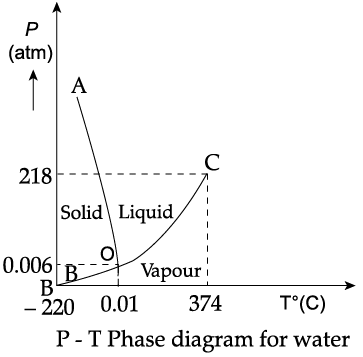
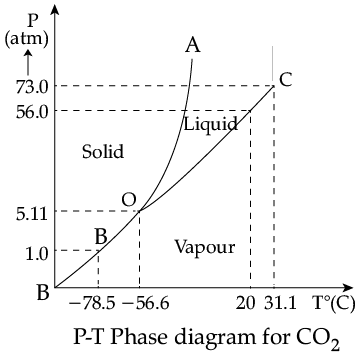 Q. Sublimation curve represents the coexistence of
Q. Sublimation curve represents the coexistence of- a)Solid and liquid state
- b)Solid and vapour state
- c)Liquid and vapour state
- d)Liquid, solid and vapour state
Correct answer is option 'B'. Can you explain this answer?
Attempt All sub parts from each question.
Triple Point: The temperature of a substance remains constant during its change of state (phase change). A graph between the temperature T and the Pressure P of the substance is called a phase diagram or P-T diagram. The following figure shows the phase diagram of water and CO2. Such a phase diagram divides the P-T plane into a solid-region, the vapour-region and the liquid-region. The regions are separated by the curves such as sublimation curve (BO), fusion curve (AO) and vaporisation curve (CO). The points on sublimation curve represent states in which solid and vapour phases coexist. The point on the sublimation curve BO represent states in which the solid and vapour phases coexist. Points on the fusion curve AO represent states in which solid and liquid phase coexist. Points on the vaporisation curve CO represent states in which the liquid and vapour phases coexist. The temperature and pressure at which the fusion curve, the vaporisation curve and the sublimation curve meet and all the three phases of a substance coexist is called the triple point of the substance.


Q. Sublimation curve represents the coexistence of
a)
Solid and liquid state
b)
Solid and vapour state
c)
Liquid and vapour state
d)
Liquid, solid and vapour state
|
|
Geetika Shah answered |
The points on sublimation curve represent states in which solid and vapour phases coexist. The point on the sublimation curve BO represent states in which the solid and vapour phases coexist.
Attempt All sub parts from each question.Triple Point: The temperature of a substance remains constant during its change of state (phase change). A graph between the temperature T and the Pressure P of the substance is called a phase diagram or P-T diagram. The following figure shows the phase diagram of water and CO2. Such a phase diagram divides the P-T plane into a solid-region, the vapour-region and the liquid-region. The regions are separated by the curves such as sublimation curve (BO), fusion curve (AO) and vaporisation curve (CO). The points on sublimation curve represent states in which solid and vapour phases coexist. The point on the sublimation curve BO represent states in which the solid and vapour phases coexist. Points on the fusion curve AO represent states in which solid and liquid phase coexist. Points on the vaporisation curve CO represent states in which the liquid and vapour phases coexist. The temperature and pressure at which the fusion curve, the vaporisation curve and the sublimation curve meet and all the three phases of a substance coexist is called the triple point of the substance.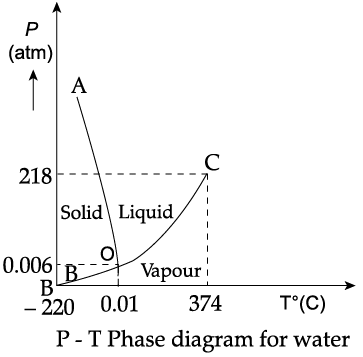
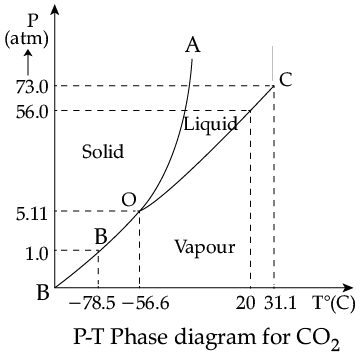 Q. Triple point of CO2 is
Q. Triple point of CO2 is- a)– 78.5°C at pressure of 1 atm.
- b)−56.4°C at pressure of 5.11 atm.
- c)−56.4K at pressure of 5.11 atm.
- d)– 78.5K at pressure of 1 atm.
Correct answer is option 'B'. Can you explain this answer?
Attempt All sub parts from each question.
Triple Point: The temperature of a substance remains constant during its change of state (phase change). A graph between the temperature T and the Pressure P of the substance is called a phase diagram or P-T diagram. The following figure shows the phase diagram of water and CO2. Such a phase diagram divides the P-T plane into a solid-region, the vapour-region and the liquid-region. The regions are separated by the curves such as sublimation curve (BO), fusion curve (AO) and vaporisation curve (CO). The points on sublimation curve represent states in which solid and vapour phases coexist. The point on the sublimation curve BO represent states in which the solid and vapour phases coexist. Points on the fusion curve AO represent states in which solid and liquid phase coexist. Points on the vaporisation curve CO represent states in which the liquid and vapour phases coexist. The temperature and pressure at which the fusion curve, the vaporisation curve and the sublimation curve meet and all the three phases of a substance coexist is called the triple point of the substance.


Q. Triple point of CO2 is
a)
– 78.5°C at pressure of 1 atm.
b)
−56.4°C at pressure of 5.11 atm.
c)
−56.4K at pressure of 5.11 atm.
d)
– 78.5K at pressure of 1 atm.
|
|
Gaurav Kumar answered |
From the graph, the triple point of CO2 is −56.4°C and a pressure of 5.11 atm.
Attempt All sub parts from each question.Triple Point: The temperature of a substance remains constant during its change of state (phase change). A graph between the temperature T and the Pressure P of the substance is called a phase diagram or P-T diagram. The following figure shows the phase diagram of water and CO2. Such a phase diagram divides the P-T plane into a solid-region, the vapour-region and the liquid-region. The regions are separated by the curves such as sublimation curve (BO), fusion curve (AO) and vaporisation curve (CO). The points on sublimation curve represent states in which solid and vapour phases coexist. The point on the sublimation curve BO represent states in which the solid and vapour phases coexist. Points on the fusion curve AO represent states in which solid and liquid phase coexist. Points on the vaporisation curve CO represent states in which the liquid and vapour phases coexist. The temperature and pressure at which the fusion curve, the vaporisation curve and the sublimation curve meet and all the three phases of a substance coexist is called the triple point of the substance.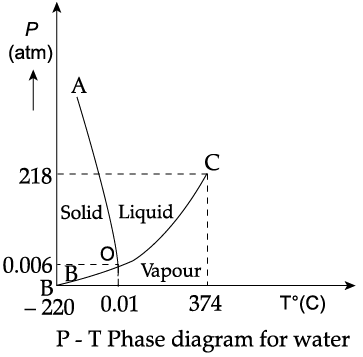
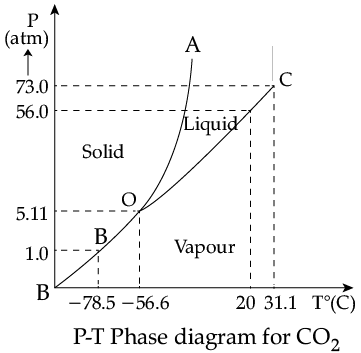 Q. The triple point of water is:
Q. The triple point of water is:- a)0.01°C at 0.006 atmosphere
- b)0.01K at 0.006 atmosphere
- c)– 0.01K at 0.006 atmosphere
- d)– 0.01°C at 0.006 atmosphere
Correct answer is option 'A'. Can you explain this answer?
Attempt All sub parts from each question.
Triple Point: The temperature of a substance remains constant during its change of state (phase change). A graph between the temperature T and the Pressure P of the substance is called a phase diagram or P-T diagram. The following figure shows the phase diagram of water and CO2. Such a phase diagram divides the P-T plane into a solid-region, the vapour-region and the liquid-region. The regions are separated by the curves such as sublimation curve (BO), fusion curve (AO) and vaporisation curve (CO). The points on sublimation curve represent states in which solid and vapour phases coexist. The point on the sublimation curve BO represent states in which the solid and vapour phases coexist. Points on the fusion curve AO represent states in which solid and liquid phase coexist. Points on the vaporisation curve CO represent states in which the liquid and vapour phases coexist. The temperature and pressure at which the fusion curve, the vaporisation curve and the sublimation curve meet and all the three phases of a substance coexist is called the triple point of the substance.


a)
0.01°C at 0.006 atmosphere
b)
0.01K at 0.006 atmosphere
c)
– 0.01K at 0.006 atmosphere
d)
– 0.01°C at 0.006 atmosphere
|
|
Nandini Iyer answered |
From the graph, the triple point of water is 0.01°C at 0.006 atmosphere pressure
Read the assertion and reason carefully to mark the correct option out of the options given below:Assertion : For higher temperature, the peak emission wavelength of a black body shifts to lower wavelengths.Reason : Peak emission wavelength of a blackbody is proportional to the fourth power of temperature.- a)If both assertion and reason are true and the reason is the correct explanation of the assertion.
- b)If both assertion and reason are true but reason is not the correct explanation of the assertion.
- c)If assertion is true but reason is false.
- d)If the assertion and reason both are false.
Correct answer is option 'C'. Can you explain this answer?
Read the assertion and reason carefully to mark the correct option out of the options given below:
Assertion : For higher temperature, the peak emission wavelength of a black body shifts to lower wavelengths.
Reason : Peak emission wavelength of a blackbody is proportional to the fourth power of temperature.
a)
If both assertion and reason are true and the reason is the correct explanation of the assertion.
b)
If both assertion and reason are true but reason is not the correct explanation of the assertion.
c)
If assertion is true but reason is false.
d)
If the assertion and reason both are false.
|
|
Pooja Shah answered |
According to Wein's law, λmT = constant
Thus peak emission wavelength λm ∝ 1/T
Hence for higher temperature, peak emission wavelength for a black body shifts to lower wavelength.
Read the assertion and reason carefully to mark the correct option out of the options given below:Assertion : Bodies radiate heat at all temperatures.Reason : Rate of radiation of heat is proportional to the fourth power of absolute temperature.- a)If both assertion and reason are true and the reason is the correct explanation of the assertion.
- b)If both assertion and reason are true but reason is not the correct explanation of the assertion.
- c)If assertion is true but reason is false.
- d)If assertion is false but reason is true.
Correct answer is option 'D'. Can you explain this answer?
Read the assertion and reason carefully to mark the correct option out of the options given below:
Assertion : Bodies radiate heat at all temperatures.
Reason : Rate of radiation of heat is proportional to the fourth power of absolute temperature.
a)
If both assertion and reason are true and the reason is the correct explanation of the assertion.
b)
If both assertion and reason are true but reason is not the correct explanation of the assertion.
c)
If assertion is true but reason is false.
d)
If assertion is false but reason is true.
|
|
Raghav Bansal answered |
Assertion is false because at absolute zero (0, K), heat is neither radiates nor absorbed. Reason is the statement of Stefan’s law, as E ∝ T4.
Which of the given relation is true for Newton’s law of cooling?- a)

- b)

- c)

- d)

Correct answer is option 'D'. Can you explain this answer?
Which of the given relation is true for Newton’s law of cooling?
a)
b)
c)
d)
|
|
Arka Bose answered |
Newton's law of cooling states that the heat released by a body with respect to time (or) the rate of heat released is directly proportional to the difference between the body's temperature and the surrounding temperature.
dH/dt = k(T – Ts) where t = surrounding's temperature and T = temperature of the body
Consider two bodies A and B, of equal surface areas, such that A's temperature is more that B's temperature and the surrounding temperature is less than both A and B. Then according to Newton's law of cooling A loses more heat to the surroundings when compared B during the same time interval. So, A will cool faster than B.
dH/dt = k(T – Ts) where t = surrounding's temperature and T = temperature of the body
Consider two bodies A and B, of equal surface areas, such that A's temperature is more that B's temperature and the surrounding temperature is less than both A and B. Then according to Newton's law of cooling A loses more heat to the surroundings when compared B during the same time interval. So, A will cool faster than B.
Attempt All sub parts from each question.Railway track expansion joint: Expansion and contraction of steel and concrete structure due to seasonal heating and cooling is a common problem found in civil engineering. To combat this problem, engineers put expansion joints to absorb these changes. This problem is compounded on railway tracks. This could lead to rail buckling, known in the industry as “sun kink”, as shown below, and cause the derailment of train. When exposed to temperature variations, the rail tends to vary its length. If this tendency is freely allowed, for a temperature
This problem is compounded on railway tracks. This could lead to rail buckling, known in the industry as “sun kink”, as shown below, and cause the derailment of train. When exposed to temperature variations, the rail tends to vary its length. If this tendency is freely allowed, for a temperature variance Δt, the rail length L will vary by ΔL. This length variance can be computed as:ΔL = αLΔtwhere α = expansion coefficient of steel= 11.5 x 10–6 °C.The coefficient of thermal expansion is defined as the fractional increase in length per unit rise in temperature. Traditional railway tracks are of standard lengths. When the tracks are laid, the lengths are joined end to end using “fishplates”—short lengths of steel plate overlapping the joint, and bolted to the ends of the rails. At each joint there must be a short gap (≈ 1/8") between the rail ends, to allow for longitudinal thermal expansion of the rails on hot days.Q. “Sun kink” is the
variance Δt, the rail length L will vary by ΔL. This length variance can be computed as:ΔL = αLΔtwhere α = expansion coefficient of steel= 11.5 x 10–6 °C.The coefficient of thermal expansion is defined as the fractional increase in length per unit rise in temperature. Traditional railway tracks are of standard lengths. When the tracks are laid, the lengths are joined end to end using “fishplates”—short lengths of steel plate overlapping the joint, and bolted to the ends of the rails. At each joint there must be a short gap (≈ 1/8") between the rail ends, to allow for longitudinal thermal expansion of the rails on hot days.Q. “Sun kink” is the- a)Buckling of railway tracks due to seasonal heating and cooling
- b)Fracture of railway tracks due to seasonal heating and cooling
- c)Buckling of railway track arising from the high pressure of loaded wagons
- d)None of the above
Correct answer is option 'A'. Can you explain this answer?
Attempt All sub parts from each question.
Railway track expansion joint: Expansion and contraction of steel and concrete structure due to seasonal heating and cooling is a common problem found in civil engineering. To combat this problem, engineers put expansion joints to absorb these changes.

This problem is compounded on railway tracks. This could lead to rail buckling, known in the industry as “sun kink”, as shown below, and cause the derailment of train. When exposed to temperature variations, the rail tends to vary its length. If this tendency is freely allowed, for a temperature

variance Δt, the rail length L will vary by ΔL. This length variance can be computed as:
ΔL = αLΔt
where α = expansion coefficient of steel
= 11.5 x 10–6 °C.
The coefficient of thermal expansion is defined as the fractional increase in length per unit rise in temperature. Traditional railway tracks are of standard lengths. When the tracks are laid, the lengths are joined end to end using “fishplates”—short lengths of steel plate overlapping the joint, and bolted to the ends of the rails. At each joint there must be a short gap (≈ 1/8") between the rail ends, to allow for longitudinal thermal expansion of the rails on hot days.
Q. “Sun kink” is the
a)
Buckling of railway tracks due to seasonal heating and cooling
b)
Fracture of railway tracks due to seasonal heating and cooling
c)
Buckling of railway track arising from the high pressure of loaded wagons
d)
None of the above
|
|
Gaurav Kumar answered |
Expansion and contraction of steel and concrete structure due to seasonal heating and cooling is a common problem found in civil engineering. This problem is predominant on railway tracks. This could lead to rail buckling, known in the industry as “sun kink”, and cause the derailment of train.
Attempt All sub parts from each question.Railway track expansion joint: Expansion and contraction of steel and concrete structure due to seasonal heating and cooling is a common problem found in civil engineering. To combat this problem, engineers put expansion joints to absorb these changes. This problem is compounded on railway tracks. This could lead to rail buckling, known in the industry as “sun kink”, as shown below, and cause the derailment of train. When exposed to temperature variations, the rail tends to vary its length. If this tendency is freely allowed, for a temperature
This problem is compounded on railway tracks. This could lead to rail buckling, known in the industry as “sun kink”, as shown below, and cause the derailment of train. When exposed to temperature variations, the rail tends to vary its length. If this tendency is freely allowed, for a temperature variance Δt, the rail length L will vary by ΔL. This length variance can be computed as:ΔL = αLΔtwhere α = expansion coefficient of steel= 11.5 x 10–6 °C.The coefficient of thermal expansion is defined as the fractional increase in length per unit rise in temperature. Traditional railway tracks are of standard lengths. When the tracks are laid, the lengths are joined end to end using “fishplates”—short lengths of steel plate overlapping the joint, and bolted to the ends of the rails. At each joint there must be a short gap (≈ 1/8") between the rail ends, to allow for longitudinal thermal expansion of the rails on hot days.Q. What will be the expansion of a 20m long railway steel track for 30°C variation of temperature?
variance Δt, the rail length L will vary by ΔL. This length variance can be computed as:ΔL = αLΔtwhere α = expansion coefficient of steel= 11.5 x 10–6 °C.The coefficient of thermal expansion is defined as the fractional increase in length per unit rise in temperature. Traditional railway tracks are of standard lengths. When the tracks are laid, the lengths are joined end to end using “fishplates”—short lengths of steel plate overlapping the joint, and bolted to the ends of the rails. At each joint there must be a short gap (≈ 1/8") between the rail ends, to allow for longitudinal thermal expansion of the rails on hot days.Q. What will be the expansion of a 20m long railway steel track for 30°C variation of temperature?- a)6.9 m
- b)6.9 cm
- c)6.9 mm
- d)0.69 m
Correct answer is option 'C'. Can you explain this answer?
Attempt All sub parts from each question.
Railway track expansion joint: Expansion and contraction of steel and concrete structure due to seasonal heating and cooling is a common problem found in civil engineering. To combat this problem, engineers put expansion joints to absorb these changes.

This problem is compounded on railway tracks. This could lead to rail buckling, known in the industry as “sun kink”, as shown below, and cause the derailment of train. When exposed to temperature variations, the rail tends to vary its length. If this tendency is freely allowed, for a temperature

variance Δt, the rail length L will vary by ΔL. This length variance can be computed as:
ΔL = αLΔt
where α = expansion coefficient of steel
= 11.5 x 10–6 °C.
The coefficient of thermal expansion is defined as the fractional increase in length per unit rise in temperature. Traditional railway tracks are of standard lengths. When the tracks are laid, the lengths are joined end to end using “fishplates”—short lengths of steel plate overlapping the joint, and bolted to the ends of the rails. At each joint there must be a short gap (≈ 1/8") between the rail ends, to allow for longitudinal thermal expansion of the rails on hot days.
Q. What will be the expansion of a 20m long railway steel track for 30°C variation of temperature?
a)
6.9 m
b)
6.9 cm
c)
6.9 mm
d)
0.69 m
|
|
Pooja Shah answered |
ΔL = αLΔt
α = 11.5 × 10–6 °C.
L = 20m
Δt = 30°C
Putting the values in the expression:
ΔL = 11.5 × 10–6 × 20 × 30
= 6.9 mm
Chapter doubts & questions for Mechanisms of Heat Transfer - Physics for EmSAT Achieve 2025 is part of EmSAT Achieve exam preparation. The chapters have been prepared according to the EmSAT Achieve exam syllabus. The Chapter doubts & questions, notes, tests & MCQs are made for EmSAT Achieve 2025 Exam. Find important definitions, questions, notes, meanings, examples, exercises, MCQs and online tests here.
Chapter doubts & questions of Mechanisms of Heat Transfer - Physics for EmSAT Achieve in English & Hindi are available as part of EmSAT Achieve exam.
Download more important topics, notes, lectures and mock test series for EmSAT Achieve Exam by signing up for free.
Physics for EmSAT Achieve
208 videos|329 docs|212 tests
|

Contact Support
Our team is online on weekdays between 10 AM - 7 PM
Typical reply within 3 hours
|
Free Exam Preparation
at your Fingertips!
Access Free Study Material - Test Series, Structured Courses, Free Videos & Study Notes and Prepare for Your Exam With Ease

 Join the 10M+ students on EduRev
Join the 10M+ students on EduRev
|

|
Create your account for free
OR
Forgot Password
OR
Signup to see your scores
go up
within 7 days!
within 7 days!
Takes less than 10 seconds to signup









